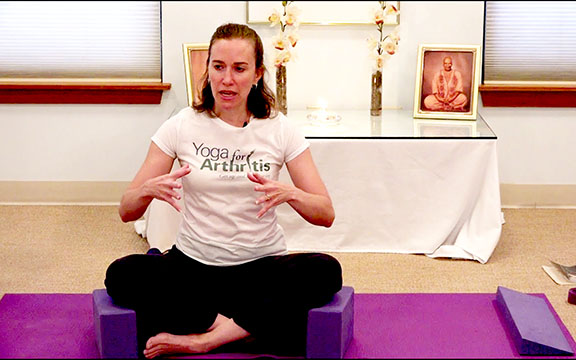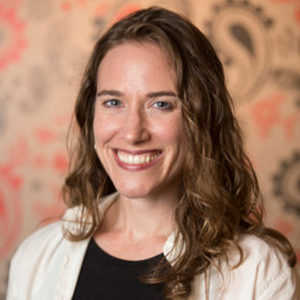 Dr. Steffany Moonaz, PhD, C-IAYT, is the founder of Yoga for Arthritis and the author of Yoga Therapy for Arthritis. She is a faculty member of the Integral Yoga Therapy Certification program (IAYT-certified), which offers a special path to a career in Yoga Therapy. The program combines the time-honored heritage of a classical Yoga lineage with practices adapted for contemporary times. Drawing from the roots of classical teachings, therapists receive a balanced and thorough training exemplifying the essence of Yoga, while providing applicable skills for modern-day implementation. In this article, Dr. Moonaz gives an overview of what Yoga Therapy essentially is comprised of.
Dr. Steffany Moonaz, PhD, C-IAYT, is the founder of Yoga for Arthritis and the author of Yoga Therapy for Arthritis. She is a faculty member of the Integral Yoga Therapy Certification program (IAYT-certified), which offers a special path to a career in Yoga Therapy. The program combines the time-honored heritage of a classical Yoga lineage with practices adapted for contemporary times. Drawing from the roots of classical teachings, therapists receive a balanced and thorough training exemplifying the essence of Yoga, while providing applicable skills for modern-day implementation. In this article, Dr. Moonaz gives an overview of what Yoga Therapy essentially is comprised of.
What Is Yoga Therapy?
Yoga therapy is a profession that applies the tools of Yoga to help address individual health concerns and foster a shift toward greater wellness. Yoga therapy considers the whole person, their individual challenges and abilities, as well as their concerns and goals. Instead of offering the same practices to everyone, Yoga therapy customizes a plan of care, recommending specific (and often modified) Yoga practices and philosophical applications as tools for self-care. While individual Yoga therapists have been practicing around the globe for many years, it is in the last decade that standards have been developed for the training and credentialing of Yoga therapists worldwide. As Yoga therapy has become credentialed and professionalized, there has been greater integration of Yoga therapists into healthcare settings, such as hospitals, senior care facilities, integrative health practices, and clinics. Yoga in these settings is being adapted for diverse patient populations. It is offered to people in hospital beds and wheelchairs, from pediatrics to geriatrics.
Unfortunately, the distinction between Yoga classes for high levels of fitness and Yoga therapy for help with managing chronic conditions remains unclear to the general population and even among many healthcare providers. While some of the research findings on Yoga have been widely disseminated, the details about their highly adapted practices have not. Individuals with limited mobility sometimes seek local Yoga classes, only to find that they are not accessible and may even exacerbate symptoms. One woman with arthritis was even told by her doctor—who practiced Yoga himself—that Yoga would not be safe. If his exposure to Yoga was vigorous and athletic, it may very well be inaccessible to his patients. However, the tools of Yoga are many, and anyone with a body and mind can bring them into union. Anyone can work toward greater mindfulness in the moment, contentment, and non-harming.
It is the role of Yoga therapists to meet clients where they are, and to focus on the goals that are important to each client, while also recognizing potential areas for growth and greater wellness. While the ultimate aim of Yoga may be union with the true Self, the means to that end will be different for each individual; it might be a reduction in physical pain, improved stress management, or greater acceptance of current circumstances. Often, the intentions of Yoga therapy change over the course of care, many times moving from gross, or obvious, to subtle. You see an example of this in the eight limbs of Yoga described above. Yoga also provides a model of perceiving the whole person in view of this gross-to-subtle shift: the PMK (Pancha Maya Kosha) model.
Yogic View of the Whole Person
Yoga has a system of understanding the whole person called the PMK model. This view perceives each person as five layers of being, moving from the most to least perceptible. The outermost layer is physical. Within that exists the energy/breath, then mental/emotional, wisdom, and ultimately bliss/spiritual connection. You may recognize this whole-person approach from the BPSS model (Bio Psycho Social Spiritual) described in one of the chapters of my book, which acknowledges the layers of influence on a person’s wellbeing. Yoga offers us a means of connecting to and balancing each layer and this balance can be assessed via HRQL (health-related quality of life) measures.
The physical layer is the most obvious. We can connect to the body, or physical self, through movement, relaxation, or a simple body scan. Within the body is the energy layer, and that is mobilized via the breath. The simplest way to tune into this layer is by noticing the flow of breath within the body. As we continue through the koshas, we move into more subtle realms. Within the breath exists the mind, or sense impressions and emotions. You can understand this as your thoughts and the interpretations of your sensory organs. This layer changes quickly (just notice how many thoughts you have in the course of one minute), but you can calm it by bringing awareness to your thoughts and feelings without judging them or by endeavoring to focus on one piece of sensory input.
More subtle than the mind is the wisdom layer, which contains not only the peaceful knowing of the “true Self,” but also our strongly held core beliefs. Unlike the mind, the wisdom layer is slow to change. You can get a sense of this level of being by acknowledging the underlying pattern in your more quickly moving thoughts. For example, thoughts about your upcoming plans, staining the deck, and your partnership may all hold a sense of time pressure, preoccupation with cleanliness, or enthusiasm about the outdoors. The themes that exist within the thoughts reveal the contents of our wisdom layer.
The wisdom layer is the closest to spirit and, despite whatever beliefs may exist there, still leads us to insights about our spiritual selves. Yoga does not define spirit, nor is it a religion. It simply acknowledges that there is a spiritual dimension to our existence. You can connect to this innermost layer through the things that allow the deepest relaxation or that bring you the greatest aliveness. What are you passionate about? What have you enjoyed since you were a child? When have you felt a pervasive sense of wellbeing? These inklings are connections to your spirit layer. Whether considering yourself or your patients/clients, it is important to remember the whole person: body, energy, mind, intellect, and spirit. HRQL considers many aspects of existence as being important to health and the function of all the levels. Each layer of being described in the BPSS and PMK models influences the other—the layers do not function independently. For example, when the physical body experiences pain, it impacts emotional wellbeing and energy levels. Conversely, when we feel more stressful emotions, it can exacerbate arthritis symptoms and even facilitate flares in autoimmune arthritis.
Each of the five layers described in the PMK model gives us insight into important aspects of our being and lifestyle. It is possible to connect to each layer through various Yoga practices such as postures, breathing, chanting, and meditation. Arthritis affects all levels of the self and Yoga can help to improve quality of life through all layers of the self.
About the Author:
 Steffany Moonaz, PhD, C-IAYT, founded Yoga for Arthritis after 8 years at Johns Hopkins University where she studied the effects of Yoga for people living with arthritis. She now serves as the Director of Clinical and Academic Research at the Maryland University of Integrative Health, which offers the nation’s only Masters of Science in Yoga Therapy. Steffany continues to conduct research on the effects of Yoga for chronic pain and joint conditions, and mentors Yoga teachers, Yoga therapists, and emerging researchers. She is passionate about ensuring that Yoga practices are safe, welcoming, and appropriate for people with arthritis nationwide.
Steffany Moonaz, PhD, C-IAYT, founded Yoga for Arthritis after 8 years at Johns Hopkins University where she studied the effects of Yoga for people living with arthritis. She now serves as the Director of Clinical and Academic Research at the Maryland University of Integrative Health, which offers the nation’s only Masters of Science in Yoga Therapy. Steffany continues to conduct research on the effects of Yoga for chronic pain and joint conditions, and mentors Yoga teachers, Yoga therapists, and emerging researchers. She is passionate about ensuring that Yoga practices are safe, welcoming, and appropriate for people with arthritis nationwide.
(Excerpted from Yoga Therapy for Arthritis by Steffany Moonaz, PhD, C-IAYT © 2020 Singing Dragon. Reprinted with permission. This article may not be reproduced for any other use without permission.)

